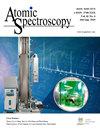朱荣火星探测器上中国首台LIBS仪器(MarSCoDe)的设计、功能与实现
IF 2.3
2区 化学
Q1 SPECTROSCOPY
引用次数: 15
摘要
火星表面成分探测器(MarSCoDe)是中国首个用于火星物质分析的仪器,它伴随着登陆乌托邦平原的朱戎火星探测器,将基于激光诱导击穿光谱(LIBS)技术探测感兴趣的火星岩石和土壤目标。MarSCoDe由一个生物指向镜(BPM)、一个光学头、一个校准目标组件(CTA)、一个光谱仪模块(SM)和一个有效载荷控制器组成。火星代码计划分析12个主要元素。为了实现对火星目标的精确定量分析和分类,采用基于粒子群优化(PSO)的定标方案对火星温度变化引起的光谱偏移进行校正,然后提出卷积神经网络(CNN)实现元素分析。最后,根据碱硅比确定火星物体的矿物类型。火星代码的探测结果将提供有关火星演化的进一步信息。在行星探测中,激光诱导击穿光谱(LIBS)由于其特殊的能力,如除尘、原位分析和分析轻元素(原子质量<20)而成为一种吸引人的元素检测技术。随着2021年美国宇航局的“毅力号”探测器和美国航天局的“朱戎号”探测器成功着陆,以及2012年美国宇航局的“好奇号”探测器成功着陆,现在有三个LIBS有效载荷在火星上工作。2021年5月15日,登陆乌托邦平原的朱荣火星车搭载了中国首个LIBS仪器——火星表面成分探测器(MarSCoDe)。其目的是探测乌托邦平原地区具有代表性的岩石和土壤目标的原子光谱,并分析火星表面的物质组成。火星代码的探测结果将提供有关火星演化的进一步信息。朱融火星车由导航和地形相机、多光谱相机、磁场探测器、气候探测器、地下探测雷达和LIBS仪器MarSCoDe组成,如图1所示。火星代码(图1中用蓝色标记)由五个部分组成:一个生物指向镜(BPM)、一个光学头(图S1)和一个校准目标组件(CTA),它们位于火星车舱室外,以及一个光谱仪模块(SM)和一个有效载荷控制器,它们位于舱室内。脉冲激光通过光学头发射和聚焦,反射到BPM上以探测岩石。来自岩石的激发LIBS信号通过光学头收集本文章由计算机程序翻译,如有差异,请以英文原文为准。
Design, Function, and Implementation of China's First LIBS Instrument (MarSCoDe) on the Zhurong Mars Rover
MarSCoDe (Mars Surface Composition Detector) is China's first instrument for Mars material analysis, which accompanies the Zhurong Mars rover landing on Utopia Planitia and will detect interested Martian rock and soil targets based on laser-induced breakdown spectroscopy (LIBS) technique. MarSCoDe consists of a bioxial pointing mirror (BPM), an optical head, a calibration targets assembly (CTA), a spectrometer module (SM) and a payload controller. The MarSCoDe is scheduled to analyze twelve major elements. To achieve accurate quantitative analysis and classification of Mars targets, a PSO (particle swarm optimization)-based calibration scheme is adopted to correct the spectral shift due to the temperature change on Mars, and then a convolutional neural network (CNN) was proposed to implement the analysis of elements. Finally, the mineral types of Martian objects will be identified according to the alkali silica ratio. The detection results of the MarSCoDe will provide further information about the evolution of Mars. In planetary exploration, laser-induced breakdown spectroscopy (LIBS) is an appealing element detection technology due to its special capabilities, such as dust removal, in situ analysis, and analysis of light elements (atomic mass <20). With the successful landing in 2021 of NASA's Perseverance rover and CNSA’s Zhurong rover, plus NASA's Curiosity rover in 2012, there are now three LIBS payloads working on Mars. The Zhurong rover landing on Utopia Planitia on May 15, 2021, contains China's first LIBS instrument, the MarSCoDe (Mars Surface Composition Detector). Its purpose is to detect the atomic spectra of representative rock and soil targets in the Utopia Planitia area and to analyze the material composition of the Martian surface. The detection results of the MarSCoDe will provide further information about the evolution of Mars. The Zhurong Mars rover consists of a navigation and terrain camera, a multispectral camera, a magnetic field detector, a climate detector, a subsurface detection radar, and the LIBS instrument, MarSCoDe, shown in Fig. 1. The MarSCoDe (marked in blue in Fig. 1) consists of five parts: a bioxial pointing mirror (BPM), an optical head (Fig. S1), and a calibration targets assembly (CTA), which are outside the rover’s cabin, and a spectrometer module (SM) and a payload controller, which are inside the cabin. Pulsed laser is emitted and focused via the optical head, which is reflected onto the BPM to detect rocks. The excited LIBS signals from the rocks are collected through the optical head
求助全文
通过发布文献求助,成功后即可免费获取论文全文。
去求助
来源期刊

Atomic Spectroscopy
物理-光谱学
CiteScore
5.30
自引率
14.70%
发文量
42
审稿时长
4.5 months
期刊介绍:
The ATOMIC SPECTROSCOPY is a peer-reviewed international journal started in 1962 by Dr. Walter Slavin and now is published by Atomic Spectroscopy Press Limited (ASPL). It is intended for the rapid publication of both original articles and review articles in the fields of AAS, AFS, ICP-OES, ICP-MS, GD-MS, TIMS, SIMS, AMS, LIBS, XRF and related techniques. Manuscripts dealing with (i) instrumentation & fundamentals, (ii) methodology development & applications, and (iii) standard reference materials (SRMs) development can be submitted for publication.
 求助内容:
求助内容: 应助结果提醒方式:
应助结果提醒方式:


